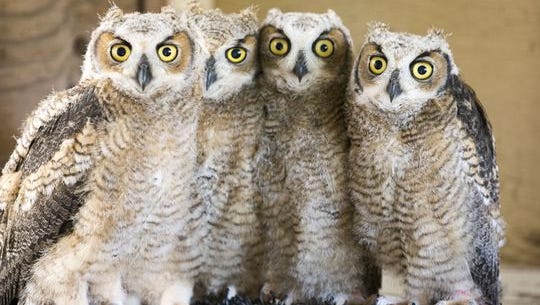Orphaned baby owls find comfort in foster mom

PHOENIX -- When four baby great horned owls were orphaned in March, Liberty Wildlife took the owlets under its wing.
The non-profit wildlife-rehabilitation organization called on a foster mother owl named Maggie for help.
In March, a Tolleson resident reported that a neighbor had shot a nesting owl out of a tree in his yard with a pellet gun, which fractured her wing. She was unable to care for her young and had to be euthanized,according to the Arizona Game and Fish Department.
Game and Fish biologists saved the four owlets, who only were a few weeks old, from the tree after determining that their father was unable to care for them all.
New mom in the wings: Rescued baby owls find foster home
New mom in the wings

Then it was Maggie's turn to help. She is one of several foster owl mothers at Liberty Wildlife in Scottsdale. The foster mother owls do not mate with male owls, so they lay infertile eggs, which helps in the process of having them take in the rescued babies as their own.
Maggie had laid infertile eggs, and the rescuers switched out the eggs for the owlets, according to Laura Hackett, program scheduler and specialist at Liberty Wildlife.
"(The babies) are, of course, scared when they first get here; they don't know what's going on," Hackett said. "Once they get in there with a mom who knows how to be a mom, she does the talking to them and they usually warm up pretty quickly."
The owlets initially were assessed to make sure they had no injuries, then were treated with fluids.
Despite not being with their biological mother, the owlets have been able to grow up normally and have learned how to catch mice on their own, communicate with their foster mother and fly within the cage. This is all thanks to Maggie, who has been fostering babies since she was rescued in 2003.
"That's what's great about having her; the babies can learn that language," Hackett said. "So they listen to mom and learn the different sounds that they are going to have to make to defend themselves in the wild," Hackett said.
Jan Miller, the animal-care coordinator for Liberty Wildlife, supervises Liberty Wildlife's foster-care system. Maggie knows Miller very well, Hackett said.
"Jan speaks owl, they have conversations," Hackett said.

The great horned owl is the most common owl in Arizona, with a distinctive "hoot." "Those eyes pull you in," Hackett said.
Miller said the owlets will eat up to 600 grams of food a day, which could mean 20 to 30 mice per bird. There is a large budget at the foundation just for buying mice.
"She still protects them, and in the wild she would still kill the mouse and bring it to them, but it's those little learning curves that they have to go through," Miller said.
The volunteers at the foundation try to have as little contact with the owls as possible.
"You want them to be wild," Miller said. She said if the birds were raised solely by humans, they could be imprinted and might not realize they were birds anymore.
Because they are a protected species, the man who shot the babies' mother was cited by Game and Fish on suspicion of taking wildlife without a license and taking wildlife in a closed season. He has pleaded not guilty.
Specializing in foster care
Liberty Wildlife fosters all kinds of birds in all kinds of circumstances, from hatchlings to those almost ready to be released into the wild.
Current tenants being fostered at the foundation are barn and burrowing owls, Harris's and Red-tailed hawks, kestrels, California condors, falcons and a bald eagle.
"This program here has been going on for many years and has been really successful," Hackett said.
Hackett said owls can live to age 30 while in captivity, which is twice as old as if they were in the wild.
"We've had some really old ladies up until old age doing this," Hackett said of the fostering program.
Some past foster moms would have up to 30 babies in one cage with them, she said.
Preparing for release into the wild

The next steps for the babies will be a move to a bigger cage, with a mentor bird. The mentor will help them master getting food on their own and overall how to be an adult owl.
Miller said the owlets should be ready for release as soon as June or July. When the babies are ready to be released, Liberty Wildlife will find an area away from their father's territory. After their time away, he would not recognize them as his own babies and could chase them out.
As for Maggie, she will know they are ready to go off and will not be too affected by not having them around anymore, Miller said.
For the volunteers at Liberty Wildlife, releasing the babies always brings a happy-sad feeling.
"You are happy for them, yet you are kind of bummed you don't get to see them anymore," Hackett said.
For more great stories like this, LIKE Humankind on Facebook.